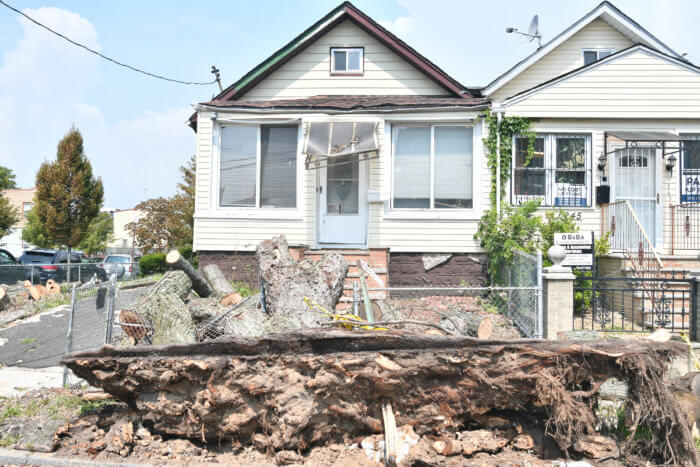One week after Tropical Storm Isaias tore through New York City, hundreds of Brooklynites are still waiting on city officials to pick up downed trees.
Dyker Heights resident Reyes Martinez, 50, said he has been waiting for seven days for the city to dispose of a gigantic tree that toppled onto his house during the Aug. 4 storm.
“We’re concerned [if there are] any winds or if it rains again, [the tree may slip and] go right on top of the house,” he said.
Martinez, wh0 filed a complaint with the city about the tree five years ago, said he called 311 close to 30 times to remove the tree, but no one responded for 72 hours.

“We were without power for three days consistently calling Con Edison, calling 311, until it came to the point when we had to go to [the local politicians],” said Martinez.
Con Edison finally arrived to his block on Aug. 7 to restore power and clear some fallen branches with the help of the Parks Department. The workers left the bulk of the fallen tree in place, but still told him later in an email that his service request was closed and that Parks “performed the work necessary to correct the condition,” he said.
Martinez added that the three days without power forced him and his wife to throw out most of their food, which was refrigerated or frozen.
“I had to throw away close to $500 worth of food,” he said.

The storm knocked out power for more than 24,000 Brooklynites and downed 10,000 trees citywide. But while Con Ed has restored most of the outages, many residents are still waiting on the Parks Department to clear the debris.
Fellow Dyker Heights native John Armento, 68, told Brooklyn Paper he’s been stuck with a hefty insurance bill after Isaias sent a tree smashing into his car.
“I was hoping they would work with me and know that I cannot drive that car, there’s no way to drive that car,” the retired sanitation worker said of his insurance company, which he also claims won’t let him cancel his plan. “I just don’t feel it’s fair … the insurance company is making me pay for a car that you can see, obviously, I can’t drive to hurt anybody, and if anybody hits me now, it don’t matter, nobody’s in the car.”
Across the borough in Canarsie, Conklin Avenue resident Gailyen Bender had to wait a full week for Parks to chop up a downed tree that landed on her family’s home of 34 years, and for Con Ed to get her electricity back up and running. As of Aug. 12, massive chunks of the felled tree still littered her front yard — but she was equally frustrated with the delayed response from her utility company.

“Con Edison should either be prepared for the next storm or relinquish their duties to the city,” Bender told Brooklyn Paper. “They need to bring in someone reliable. No one should have to go a week without power.”
In Bay Ridge, some residents lost power for a few days — but those living near 86th Street and Narrows Avenue said the outage turned off a nearby traffic light that only started working again on Aug. 12. The neighborhood’s sprawling Shore Road Park also saw a downed tree near its playground, which as of Wednesday had not yet been removed.
When reached for comment, a Parks Department spokesperson said the agency has addressed at least three quarters of its Isaias-related emergencies, such as impassible streets, trees on houses, and trees on electrical wires, which receive the highest priority. Parks officials received more than 8,000 emergency work orders citywide and 2,000 total work orders in Brooklyn, a spokesman said.
At a press conference on Aug. 11, local elected officials slammed the city for turning a blind eye to southern Brooklyn yet again.
“Eight years since Hurricane Sandy, apparently we haven’t learned very much,” said Councilman Justin Brannan. “The reason why hundreds of thousands of people were without power and people are still without power today is because trees like this were ignored. There is a direct connection between trees like this being ignored for maintenance, and the massive power outages that we saw.”
Brannan said he will work with local Community Board 10 District Manager Josephine Beckmann to put together a list of trees that had been reported to the city prior to the storm.
“We’re getting tired of recovering, we need to be prepared,” said Brannan, who chairs the Council’s Committee on Resiliency and Waterfront.
Borough President Eric Adams slammed the city’s all-controlling power purveyor for not moving to bury the remainder of the borough’s above-ground power lines.

“How many times do we have to go through the storm to realize that storms are going to come and they’re going to get increasingly more destructive?” he said.
More than 250,000 households in New York City and Westchester were left without power after Isaias — marking the second-largest power outage in the company’s history following Superstorm Sandy. In Brooklyn, a large pocket of outages were concentrated along the borough’s southern and southeastern neighborhoods, while the distant isle of Manhattan’s power grid remained mostly unscathed through the storm.
“I can’t help but believe that this slow outer-borough response is reflective of how many of our agencies see what happens in the outer boroughs is not as severe or significant as what happens in our business sector but it is just as important and we need to understand that,” Adams added.
Additional reporting by Paul Frangipane and Lloyd Mitchell.
Update (Aug. 13): This story has been updated to include that Councilman Justin Brannan chairs the New York City Council’s Committee on Resiliency and Waterfront.

























